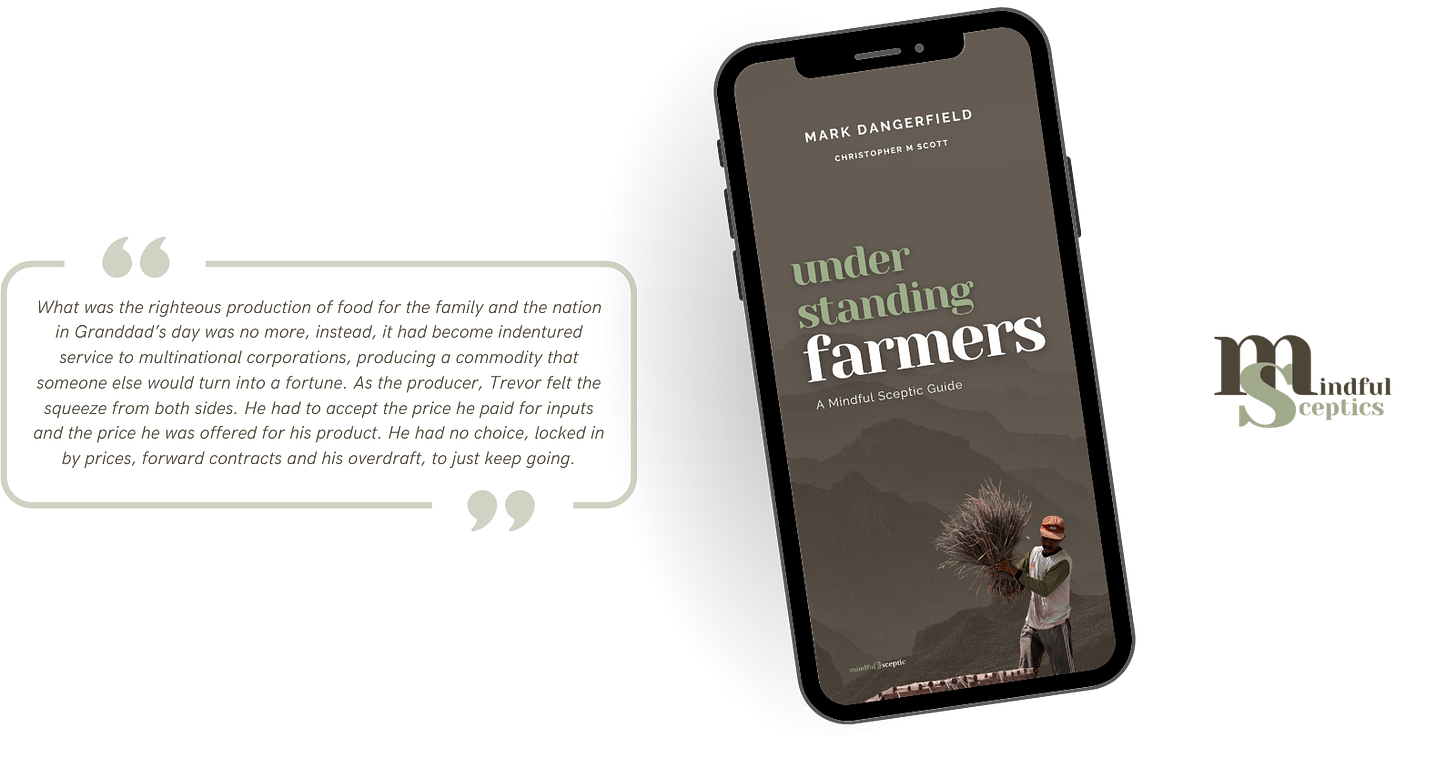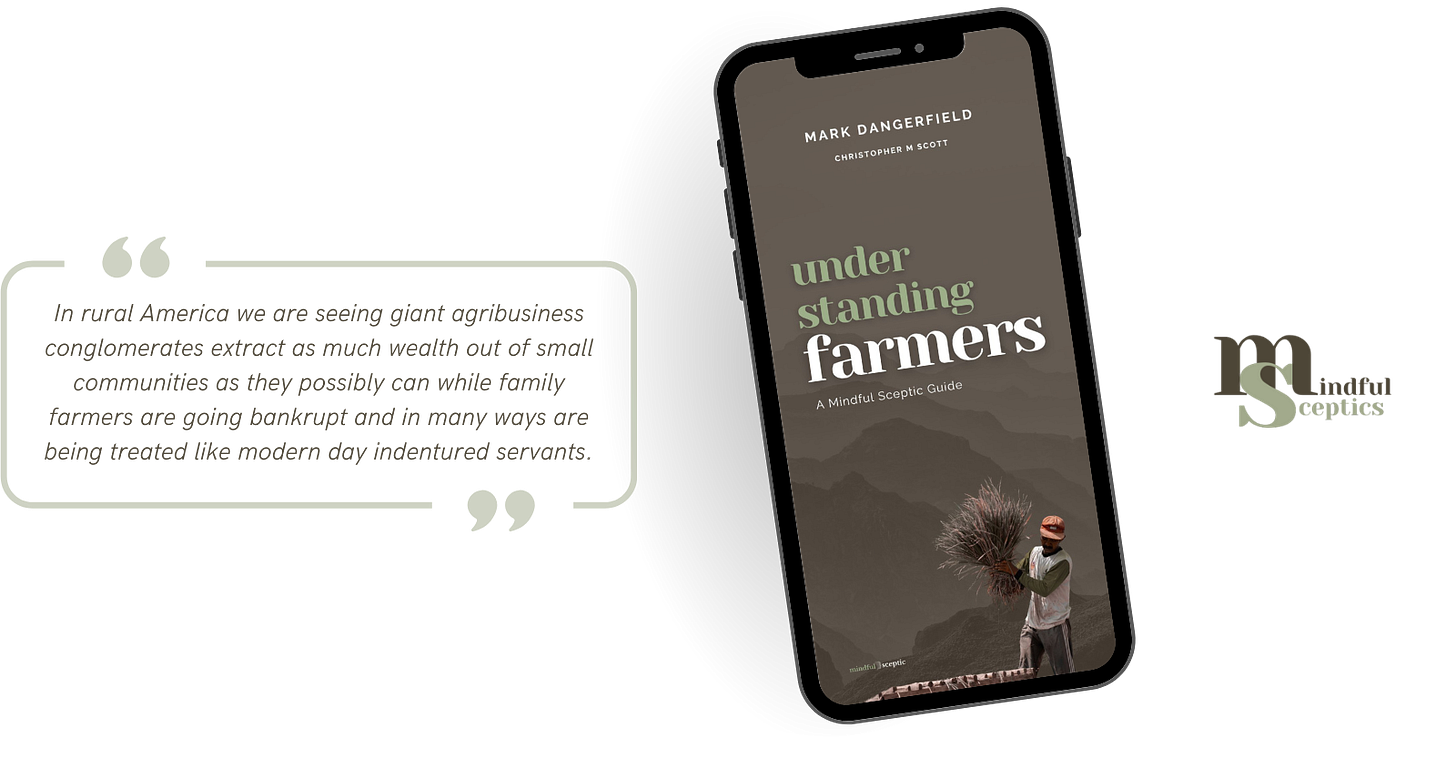Modern Indentured Servants
How corporate supply chains turned producers into price takers
Core Idea
The story we tell ourselves is elegant.
Independent farmers work their land, compete fairly, and feed a grateful nation. Free markets reward innovation and hard work. Family traditions pass from father to son as they lean on a fence, staring at the sunset across the field.
The pastoral ideal lives on in our collective imagination, right alongside the notion that farmers are their own bosses.
Here’s what that story misses. Today’s farmers exist within systems that have systematically stripped away their autonomy.
They cannot fix their own machinery because John Deere holds the software keys.
They cannot save seeds because patent law prevents it.
They cannot set prices because commodity markets do that for them.
They take the prices they’re given for inputs and outputs, squeezed between corporations that control both ends of the transaction.
Bernie Sanders called this indentured servitude, and he wasn’t being hyperbolic. The parallel runs deeper than rhetoric suggests.
Counterpoint
The rebuttal comes quickly from agricultural lobby groups and free-market defenders. Farmers are business owners. They make choices. They can diversify crops, adopt new technologies, or exit the industry if it doesn’t work.
Family farmers are independent entrepreneurs who choose their profession freely.
No one forced them onto the land.
This misses the structural reality. Modern agriculture creates what economists call “asset specificity”, which is investments that lock you into particular relationships. Purchasing a million-dollar combine harvester requires farming enough acres to justify the investment. Sign contracts with Tyson or Cargill, and you build sheds designed for their specifications. Take on debt secured by the land your grandfather farmed, and you cannot simply walk away.
The “choice” becomes illusory when the alternatives evaporate. Small-scale direct marketing is effective for only a tiny fraction of farmers. Everyone else operates within industrial food systems that set the terms. You plant what the elevator will buy, when they want it, at prices determined by Chicago futures markets you never see.
Most tellingly, farmers consistently work for less than minimum wage when you calculate their actual hours against their net income. They persist not because it’s profitable, but because the sunk costs, especially in land, equipment, and identity, make exit impossible.
The system functions precisely because it traps competent people in activities that generate value for others while keeping producers permanently on the edge of viability.
Thought Challenge
Follow the money backwards... Next time you buy food, trace one item’s journey in reverse. Find out who set the farmer’s price, who controlled the inputs, and who owns the processing facility. Notice how many decision points the person who grew your food actually controlled.
Apply the substitution test... Imagine a factory worker who couldn’t fix their own tools, couldn’t choose their suppliers, couldn’t set their wages, and worked 70-hour workweeks for below-minimum-wage returns. Would anyone call that person “independent”? What makes farming different?
Closing Reflection
The language matters here. We call farmers “producers,” but production implies control over process and output. Modern farmers are better understood as contractors in a system they cannot influence.
This isn’t a condemnation of individual farmers, as they work within structures they inherited, and we would be lost without them. Nor is it romantic nostalgia for yeoman agriculture that never quite existed as advertised.
However, it is recognition that power concentrates, and that concentration has consequences. Free markets require actual freedom to function. When corporations control seeds, software, processing, and distribution, farmers become more like employees on lousy pay and conditions. Real employees get overtime pay and workplace protections.
The mindful sceptic asks uncomfortable questions about comfortable stories.
The story of agricultural independence is one of our most cherished myths. The reality is more complex and more troubling than the mythology suggests.
Evidence Support
Hendrickson, M. K., & James, H. S. Jr. (2005). The Ethics of Constrained Choice: How the Industrialization of Agriculture Impacts Farming and Farmer Behavior. Journal of Agricultural and Environmental Ethics, 18(3), 269–291.
TL;DR… the industrialisation of agriculture severely restricts the choices available to farmers by structuring markets in a way that automatically favours large-scale actors and leaves most producers price-takers with limited autonomy. The authors argue that as supply chains consolidate, farmers have to comply with new contracts, cost structures, and production practices dictated by well-capitalised corporations.
Relevance to insight… limited agency and dependency are not accidents, but consequences of how agricultural markets are structured—directly supporting the insight that most farmers are not “captains of their destiny,” but operate in roles engineered for dependence and subordination.
Howard, P. H. (2016). Concentration and Power in the Food System: Who Controls What We Eat? Bloomsbury Academic.
TL;DR… progressive consolidation of ownership and power at every node of the global food supply chain, especially post-1980s. His analysis shows that a small number of vertically and horizontally integrated corporations command critical control over seeds, agrochemicals, processing, and retail, leaving farmers facing monopsonistic buyers and oligopolistic sellers.
Relevance to insight… market concentration squeezes farmers’ margins, erases bargaining power, and fosters a system where producers are “locked in” by prices, contracts, and corporate policies.
MacDonald, J. M., & McBride, W. D. (2009). The Transformation of U.S. Livestock Agriculture: Scale, Efficiency, and Risks. Economic Information Bulletin No. 43, USDA Economic Research Service.
TL;DR… as livestock production has shifted to contract-based, vertically integrated supply chains, independent producer autonomy has sharply declined, with processors controlling genetics, feed, schedules, and prices. Profit risk has shifted onto farmers, while corporations in the chain control price discovery and input channels.
Relevance to insight… direct evidence that contract farming and concentrate supply chains systematically erode farmer agency and foster long-term dependency—core claims of the insight.
Clapp, J. (2016). Food. Polity Press.
TL;DR… how global agrifood chains, shaped by liberalised trade, financialization, and input sector consolidation, have made cost structures and output prices almost entirely outside the farmer’s control. The farm share of the consumer food dollar is declining, while volatility and risk are primarily absorbed by farmers rather than powerful downstream actors.
Relevance to insight… essential reading for understanding why modern farmers are rarely able to “lift themselves up” and often remain at the mercy of input suppliers and buyers, in full alignment with the insight’s core argument.
Bonanno, A., & Constance, D. H. (Eds.). (2010). Stories of Globalization: Transnational Corporations, Resistance, and the State. Penn State University Press.
TL;DR… how structural adjustment, global mergers, and neoliberal policies have intensified vertical and horizontal integration in agri-food markets, resulting in what the editors call the “subsumption of family farmers” under transnational capital and restrictive contract terms.
Relevance to insight… multiple cross-national case studies showing how institutional dependency and lack of bargaining power are deliberately cultivated by corporate food systems, reinforcing the insight that farmers are “locked in, not lifted up.”






